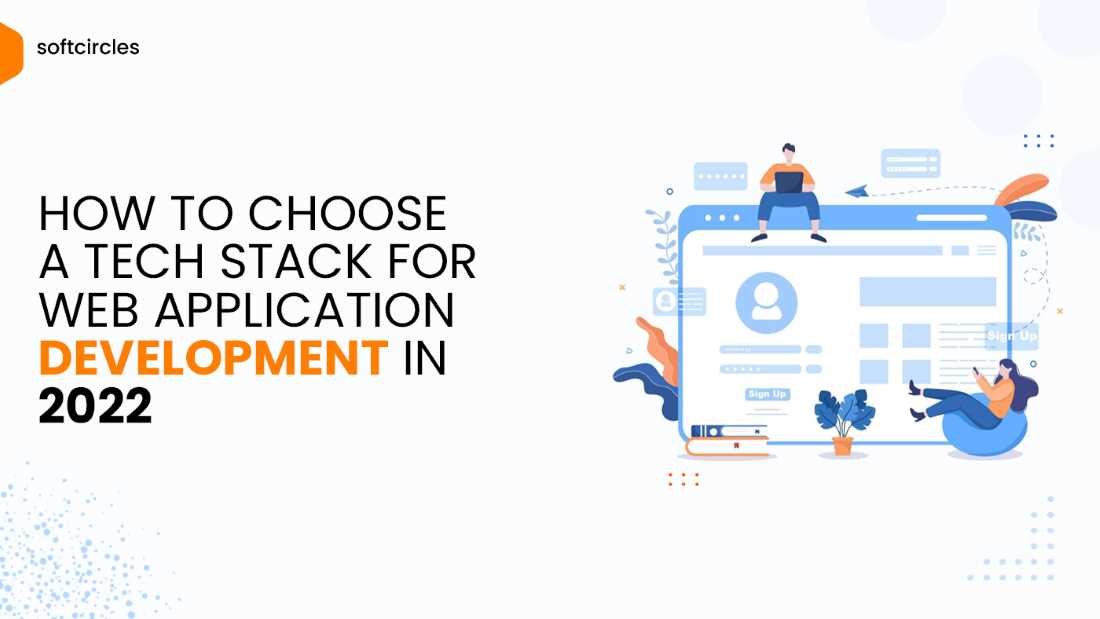How To Choose a tech stack for Web Application Development in 2022

Selecting the best tech stack for web app development is an essential step in the life of your app or web development project. It serves as a foundation for creating customized products for your specific needs and enhancing their performance. A good technology stack ensures that your product meets your customers' expectations and fulfills your requirements. As a result, selecting an appropriate tech stack for web development aligned with the demands of your product from the beginning eliminates many future complications, such as fixing or updating cases. Although no two businesses have the same goals, we can identify standard requirements when starting a new software development project:
- When new features are required, they must be implemented.
- Being a customizable company;
- To grow into a scalable business;
- To create an MVP on time;
- Want a quick iteration?
- I prefer tech stacks that are simple to integrate with other technologies or software;
What is Tech Stack?
A tech stack describes the programming languages, operating systems, and frameworks your software developers will use to build your custom application or web development project. Most web development projects use different technologies, but they frequently share fundamental concerns. Every website requires: 1. A database like MySQL or MongoDB to store information; 2. Use a backend framework such as Rails, Express, or Django to react to HTTP. 3. To create rich and interactive client-side applications, use a client-side framework such as Angular, React, or Redux.The most used tech stack for web application development in 2022?
When it comes to web app development, we must consider the structure of the technology stack from two perspectives:- Frontend web development
- Backend web development
Front-end Web Development
Front-end web development allows users to see and interact with your app. Client-side technologies are used in front-end development because they are responsible for user interaction. Web browsers such as Safari and Chrome handle user interaction.HTML and CSS
Hypertext Markup Language (HTML) and Cascading Style Sheets (CSS) are the backbones of web development. HTML helps design the front of web pages by defining the link between the web pages. On the other hand, CSS makes web pages appealing by managing the design components.JavaScript
JS is a programming language that is mostly used on the Internet. When it comes to web app development, it can improve the web app's functionality. AngularJS, ReactJS, etc., are popular JavaScript-based frameworks extensively used to develop user-friendly and interactive web apps. HTML and CSS both frameworks are both helpful. Bootstrap shortens development time. Furthermore, it aids in the creation of responsive websites that are rendered consistently across all modern browsers. When working on the interface, developers have more freedom with the foundation. Without specialized tool kits, no JavaScript tech stack is complete. That tool kits speed up web development and provide a structured code organization. The most popular frameworks are jQuery, Angular.js, React.js, and Vue.js. It is also critical to understand their features and application domains. According to Stack Overflow's survey, React.js is the most widely used framework for web development:Back-end web development - Tech Stack for Web App
Back-end web development aims to power the front-end while allowing users to perform specific actions. Because this portion is not visible to users, it is referred to as server-side technologies. Programming languages, servers, and databases are examples of backend technologies. We will discuss the most important programming languages and databases in this section.Programming language
- PHP
- Java
- C++
- Ruby
Databases
Databases are used to store data indefinitely. They can be relational or non-relational. Non-relational (non-SQL) databases, such as MongoDB, use various data storage and retrieval models.- Oracle
- MongoDB
Servers
- Nginx
- Apache
How to choose the best tech stack?
Tech stacks are constantly evolving due to the advancement of modern technologies at every turn. Developers now have access to various tools for creating robust products. To select a tech stack, we must consider the time and resources required and the quality of the technologies used for the project. Each web application's size and feature requirements are unique. Scalability, duration, security, and the cost of developing a web app are also essential considerations. Let us go over all the critical elements for creating a web application with the desired features and excellent functionality.1. The objectives and requirements of your product
Begin by assessing your product vision and the functionality that will develop to realize that vision. For example, if your product or service handles large amounts of data, you should prioritize data-handling technologies that are fast and efficient.2. Importance of your chosen technology stack
Spending more money on fully prepared technologies may help you build your product faster, but it may come at a cost if the tools are not as configurable as you might like. If less expensive technologies do not meet the technical standards you require, they may pose other risks. A suitable technology stack should reduce costs while increasing value in the end.3. App size
When choosing the right technology stack, the size of your web app is most important. The reason is simple: as your web app grows in size, it becomes more complex, necessitating a more advanced and robust tech stack.- Small web apps consist of 1 to 3 web pages, portfolios, and other web-based solutions.
- Large web apps: Large web apps include social networking apps and on-demand marketplaces.
